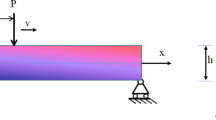Abstract
This paper presents an extension of the dual boundary element method to analysis of crack growth in plates loaded in combine bending and tension. Five stress intensity factors, two for membrane behaviour and three for shear deformable plate bending are computed using the J-Integral technique. Crack growth processes are simulated with an incremental crack extension analysis based on the maximum principal stress criterion. The method is considered effective since no remeshing is required and the crack extension is modelled by adding new boundary elements to the previous crack boundaries. Several incremental crack growth analysis for different configurations and loadings are presented.
Similar content being viewed by others
References
Abramowitz, M. and Stegun, I.A. (eds) (1965). Handbook of Mathematical Functions, Dover, New York.
Ahmadi-Brooghani, S.Y. and Wearing, J.L. (1996). The Application of the Dual Boundary Element Method in Linear Elastic Crack Problem in Plate Bending. Boundary Element Methods XVIII, edited by Brebbia, C.A., Martins, J.B., Aliabadi, M.H. and Haie, N., CMP, Portugal,pp. 429–438.
Aliabadi, M.H. (1990). Evaluation of Mixed Mode Stress Intensity Factors Using the Path Independent J-Integral. Proceeding of Boundary Elements in Engineering XII, Hokaido, Japan. Computational Mechanics Publications, Southampton, UK.
Aliabadi, M.H. and Rooke, D.P. (1991). Numerical Fracture Mechanics, Kluwer Academic Publisher, Dordrecht, The Netherlands.
Aliabadi, M.H. (1997a). Boundary eleme nt formulations in fracture mechanics. Applied Mechanics Review 50, 83–96.
Aliabadi, M.H. (1997b). A new generation of boundary element methods in fracture mechanics. International Journal of Fracture 86, 91–125.
Alwar, R.S. and Ramachandran, K. N. (1983). Influence of crack closure on the stress intensity factor for plates subjected to bending - a 3-D finite element analysis. Engineering Fracture Mechanics 17, 323–333.
Bodurolgu, H. and Erdogan, F. (1983). Internal and edge cracks in a plate of finite width under bending. Transactions of the ASME. Journal of Applied Mechanics 50, 621–629.
Erdogan, F. and Sih, G.C. (1963). On the crack extension of plates under plane loading and transverse shear. Journal of Basic Engineering 85, 519–527.
Hudson, C.M. (1969). Effect of Stress Ratio on Fatigue-Crack Growth in 7075-T6 and 2024-T3 Aluminium Alloy-Specimens, NASA TN D5390, NASA Langley Research Center.
Hussain, M.A., Pu, S.U. and Underwood, J. (1974). Strain energy release rate for a crack under combined mode I and II. ASTM STP 560, 2–28.
Knops, B. (1994). Numerical simulation of crack growth in pressurized fuselages. Ph.D Thesis, Faculty of Aerospace engineering, Delft University of Technology, The Netherlands.
Murakami et al. (ed.) (1987). Stress Intensity Factors Handbook, Pergamon Press, London.
Portela, A., Aliabadi, M.H. and Rooke, D.P. (1992). The dual boundary element method: effective implementation for crack problems. International Journal for Numerical Methods in Engineering 33, 1269–1287.
Portela, A., Aliabadi, M.H. and Rooke, D.P. (1993). Dual boundary incremental analysis of crack propagation. Computer and Structures 46, 237–247.
Potyondy, D.O. et al. (1995). Discrete crack growth analysis methodology for through cracks in pressurized fuselage structure. International Journal for Numerical Methods in Engineering 38, 1611–1633.
Rashed, Y.F., Aliabadi, M.H. and Brebbia, C.A. (1998). Hypersingular boundary element formulation for Reissner lates. International Journal of Solids and Structures 35, 2229–2249.
Reissner, E. (1947). On bending of elastic plates. Quarterly of Applied Mathematics 5, 55–68.
Rigby, R.H. and Aliabadi, M.H. (1993). Mixed mode J-integral method for analysis of 3D fracture problems using EM. Engineering Analysis with Boundary Elements 11, 239–256.
Rigby, R.H. and Aliabadi, M.H. (1998). Decomposition of the mixed mode J-integral - revisited. International ournal Solids and Structures 35, 2073–2099.
Sih, G.C. (1974). Strain energy density factor applied to mixed mode crack problems. International Journal of racture Mechanics 10, 305–321.
Sih, G.C. (1977). Strain Energy Density Theory Applied to Plate Bending Problems In: Plates and Shells with racks, vol. 3, Mechanics of Fracture, Noordhoff International Publishing, Leiden, pp. XVII–XLVIII.
Sosa, H.A. and Eischen, J.W. (1986). Computation of stress intensity factors for plate bending via a pathindependent ntegral. Engineering Fracture Mechanics 25, 451–462.
Sosa, H. and Herrmann, G. (1989). On invariant integrals in the analysis of cracked plates. International Journal f Fracture 40, 111–126.
Telles, J.C.F. (1987). A self-adaptive coordinate transformation for efficient numerical evaluation of general oundary element integrals. International Journal for Numerical Methods in Engineering 24, 959–973.
Timoshenko, S.P. and Woinowsky-Krieger, S. (1959). Theory of Plates and hells, 2nd ed., McGraw-Hill Book Co., Singapore.
Vander Weeën, F. (1982). Application of the boundary integral equation method to Reissner's plate model. nternational Journal for Numerical Methods in Engineering 18, 1–10.
Viz, M.J., Zehnder, A. and Bamford, J.D. (1995). Fatigue Fracture of thin plates under Tensile and Transverse hear Stress In: Fracture Mechanics (edited by Reuter, W.G., Underwood, J.H., and Newman Jr, J.C.) American Society for Testing and Materials, Philadelphia.
Viz, M.J. et al. (1995). Computation of membrane and bending stress intensity factors for thin, cracked plates. International Journal of Fracture 72, 21–28.
Author information
Authors and Affiliations
Rights and permissions
About this article
Cite this article
Dirgantara, T., Aliabadi, M. Crack Growth analysis of plates Loaded by bending and tension using dual boundary element method. International Journal of Fracture 105, 27–47 (2000). https://doi.org/10.1023/A:1007696111995
Issue Date:
DOI: https://doi.org/10.1023/A:1007696111995




